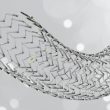This research, which included thousands of patients treated for chronic inferior limb ischemia with drug-coated balloons, did not show an association between said devices and the increased mortality observed in some randomized trials. The long-term evidence from plenty of real-world patients contradicts what has been shown in randomized trials, leaving an information gap. Endovascular revascularization...
Common Femoral Artery Endarterectomy Plus Angioplasty in Critical Ischemia
This prospective study analyzed patients with critical lower limb ischemia (due to complex, multiple lesions in several places) who were treated uniformly with common femoral artery endarterectomy combined with angioplasty to improve inflow and/or outflow. This hybrid treatment, which must be carried out by a team, can be greatly beneficial for this high-risk patient group...
Surprises in the Physiopathology of Critical Ischemia
Luminal thrombotic occlusions associated with non-significant atherosclerosis are commonly observed in patients with critical lower limb ischemia, which suggests the possibility of thromboembolic disease as a great contributor to ischemia. This was particularly verifiable in infrapopliteal vessels, thus showing a possible mechanism of progression from peripheral vascular disease to critical ischemia, as well as a...
Lesion Targeting Seems to Be the Secret in Critical Ischemia
Ulcers that do not heal, thus threatening the integrity of a lower limb in patients with critical ischemia, is a main concern. Sometimes, despite successful revascularization, major amputation cannot be prevented. The anatomical description of angiosomes started in the 70s as a way of optimizing tissue grafts. Angiosomes are basically blocks of tissue that include...
Angioplasty vs. Surgery in Long-Term Critical Ischemia
Critical ischemia is the most advanced form of peripheral arterial disease, and it is characterized by ischemic rest pain and ulcers or gangrene. Revascularization is obviously positioned as the first-line treatment, and guidelines recommend both possible strategies (surgery or angioplasty) largely based on the findings of the BASIL trial (British Angioplasty versus Surgery in Ischemic...
Critical ischemia in the lower limbs: Frequent Readmissions show the magnitude of this problem
Readmissions at 6 months in patients with critical ischemia in the lower limbs occur in about 50% of all cases and most of them are unplanned. This truly alarming number is cause for further concern when taking into account that only part of these readmissions are related to vascular problems. Many are caused by comorbidities...
DES in critical ischemia caused by infrapopliteal lesions
Original Title: Percutaneous Transluminal Angioplasty and Drug-Eluting Stents for Infrapopliteal Lesions in Critical Limb Ischemia (PADI) Trial. Reference: Marlon I. Spreen et al. Circ Cardiovasc Interv. 2016 Feb;9(2):e002376. The treatment of infrapopliteal lesions in patients with critical limb ischemia is limited by the high rates of restenosis. The most frequent course of treatment is...
Critical ischemia: An overview of the problem. Goals of the multidisciplinary approach
Bluro, Ignacio Martin (Argentina)2014-04-24
Infrapatellar balloon angioplasty, the easiest option and with better results in critical ischemia with tissue loss
Original title: Longitudinal outcomes After Tibioperoneal Angioplasty Alone Compared to Tibial Stenting and Atherectomy for Critical Limb ischemia. Reference: Shaun Reynolds et al. Vascular and and Endovascular Surgery 2013 47(7):507-512 The Infrapatellar peripheral vascular disease has increased in recent years, relating to tissue loss and amputation. The therapeutic strategy is not clear, let alone the use of stents...
LIFE-BTK | Critical Limb Ischemia: Use of Bioresorbable Scaffold in Infrapatellar Lesions (LIFE-BTK)
Advanced stages of peripheral artery disease cause significant limitations in patients, such as critical limb ischemia (CLI), which manifests with resting pain and gangrene or ulcers of difficult resolution. Uncontrolled progression of this pathology might lead to major amputation, reduced life expectancy and increased healthcare costs. Prior research on infrapopliteal territory have shown contradicting results....









